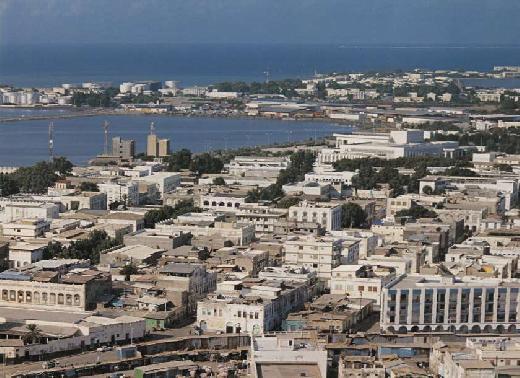The name of the country Tunisia takes its name from its capital city of Tunis. It may be related to the Berber root word for “to lay down” or “encampment” and may also be related to the ancient city of Tynes. Before this area became known as Tunisia, it was known as Ifriqiya, which lent its name to the word Africa, that the whole continent is now known.
Tunisia is located in northern Africa, nestled in between Algeria to the west and Libya to the east. It also has a coastline along the Mediterranean Sea. Directly north of it is the Italian island of Sardinia, and to the northeast is the Italian island of Sicily and the country of Malta. The eastern end of the Atlas Mountains touch Tunisia as does the northern edge of the Sahara Desert. However, much of the country is on fertile land. So, even though it’s not that large of a country, compared to other north African countries, it’s quite diverse in its environment. Tunisia and Algeria have some salt lakes called chotts that run along the northern edge of the Sahara; the largest one is in Tunisia and called Chott el Djerid.
Ancient Berbers were the first ones to live and farm in this area. The Phoenicians then settled here and set up the city of Carthage in the 9th century BC. It would become a major city in the Western Mediterranean. They were engaged in wars with Greek-run Sicily, and then Carthage (under the guidance of Hannibal) attacked Rome in a series of wars called the Punic Wars. There was a lot of prosperity during this time as an exporter of olive oil and cereal grains. During the Middle Ages, the Arabs expanded their territory across northern Africa. It took a while to convert all the people (ya think?), but one of the first Islamic cities was Kairouan, home to one of the oldest mosques in this area, the Mosque of Uqba. By the 1500s, the Ottomans were on the move and the areas around the Mediterranean were in its sights. They took over Tunis, and after they endured fighting with European forces, Tunisia lost a lot of its territory and was in a lot of debt. So, now enters France, who took it under its wing as a protectorate. French people (as well as Italians) started moving into Tunisia. During WWII, Vichy Tunisia was occupied by Nazi Germany briefly and was the site of a series of battles. Tunisia finally declared its independence from France in 1956 and announced itself as a republic a year later. In many ways, Tunisia was one of the more modern countries, yet there were many ways in that it was quite repressive to its citizens. Extremely unhappy with then-President Ben Ali over corruption, mismanagement, human rights issues against political adversaries, lack of free speech, high unemployment, and inflation, Tunisians led a revolt and revolution in 2011. It took awhile for things to settle down, and there was quite a shift in leadership and how things were done after that.
The capital city is the northern port city of Tunis. The ancient city of Carthage is a suburb of Tunis. Originally a Berber settlement, evidence of Tunis as a city dates back to the 4th century BC. The city’s ancient medina is listed as a World Heritage Site. As old as this city is and has preserved many of its oldest landmarks, it’s also quite a modern city. With museums, parks, universities, sports venues, restaurants and nightlife, it’s no wonder why Tunis is often the site for international festivals and conventions.
Tunisia is known for having a diverse economy from agriculture, manufacturing, tourism, petroleum, and some mining. Several years ago, they were ranked the most competitive economy in Africa, and today they have several multinational companies with offices in Tunisia. However, they are mainly an export country, with strong partnerships with the EU. Right now, there’s a lot of growth happening with several big building projects on the horizon.
Nearly 98% of Tunisians are Muslim (mostly Sunni), with the remaining 2% being Christian, Jewish, or some other religion. They’re generally fairly tolerant of people being of other religions, as long as you follow the rules of Ramadan. A few years ago, several men were arrested and handed a month-long jail sentence for eating in public. Sheesh.
Arabic is the official language of Tunisia, but more specifically, Tunisian Arabic (also called Tounsi). And because Tunisia was originally Berber land, there are smaller numbers of people who speak some Berber languages, known collectively as Jebbali or Shelha (not sure why there are two names). Although it’s not an official language, French is often used in education, business, and the media, not to mention that many signs are written in both Arabic and French. Since there has been a small Italian population for a long time, there are also pockets of people who speak Italian.
 |
| Tataouine from Star Wars is a real city in Tunisia of the same name. |
Tunisia has long been involved in the film industry. When the Lumière brothers first created their famous camera and started filming, Tunis was one of the places he showcased his films and animation. And it wasn’t long before their landscape became the backdrop for other films to create their worlds, like Star Wars (including Episode 1: The Phantom Menace and Episode II: Attack of the Clones), The English Patient, Monty Python’s Life of Brian, Raiders of the Lost Ark, The Little Prince, and Where To Invade Next. The place I can’t wait to invade is my kitchen when I make Tunisian food soon.
Up next: art and literature





















